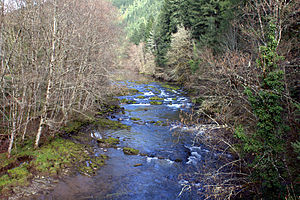| Blue River | |
|---|---|
 Flowing through the forest | |
| Location | |
| Country | United States |
| State | Oregon |
| County | Lane and Linn |
| Physical characteristics | |
| Source | Confluence of Wolf Creek and Mann Creek |
| • location | Willamette National Forest, Cascade Range, Linn County |
| • coordinates | 44°17′41″N 122°10′17″W / 44.29472°N 122.17139°W[1] |
| • elevation | 2,504 ft (763 m)[2] |
| Mouth | McKenzie River |
• location | Blue River, Lane County |
• coordinates | 44°09′15″N 122°20′42″W / 44.15417°N 122.34500°W[1] |
• elevation | 1,040 ft (320 m)[1] |
| Length | 17 mi (27 km)[3] |
| Basin size | 87 sq mi (230 km2)[4] |
| Discharge | |
| • location | near Blue River, 0.9 miles (1.4 km) from the mouth[5] |
| • average | 457 cu ft/s (12.9 m3/s)[5] |
| • minimum | 0.80 cu ft/s (0.023 m3/s) |
| • maximum | 7,270 cu ft/s (206 m3/s) |
Blue River is a tributary of the McKenzie River in Linn and Lane counties in the U.S. state of Oregon. From its source at the confluence of Mann and Wolf creeks in the Cascade Range, it flows generally southwest to join the McKenzie near the community of Blue River.[3] Saddle Dam and Blue River Dam block the river about 2 miles (3 km) from its mouth to form Blue River Reservoir, a multipurpose impoundment built in 1968 by the United States Army Corps of Engineers.[6]
The river's watershed lies almost entirely within the Willamette National Forest, dominated by western hemlock and Douglas-fir.[6] Blue River was named for the striking blue color that apparently comes from its rocky bed.[7][8]
- ^ a b c "Blue River". Geographic Names Information System (GNIS). United States Geological Survey. November 28, 1980. Retrieved December 26, 2012.
- ^ Source elevation derived from Google Earth search using GNIS source coordinates.
- ^ a b United States Geological Survey (USGS). "United States Geological Survey Topographic Map". TopoQuest. Retrieved December 26, 2012. Map quadrangles show river mileage for the first 9 miles (14 km) of the Blue River. The remaining distance is an estimate based on map scale and ruler. The relevant quadrangles are, from mouth to source, Blue River, McKenzie Bridge, and Carpenter Mountain.
- ^ "Willamette Basin TMDL: McKenzie Subbasin" (PDF). Oregon Department of Environmental Quality. p. 6. Archived from the original (PDF) on 2016-05-09. Retrieved December 26, 2012.
- ^ a b "Water-Data Report 2011: USGS 14162200 Blue River at Blue River, OR" (PDF). United States Geological Survey. Retrieved December 26, 2012.
- ^ a b Johnson, Daniel M.; Petersen, Richard R.; Lycan, D. Richard; Sweet, James W.; Neuhaus, Mark E.; Schaedel, Andrew L. (1985). Atlas of Oregon Lakes. Corvallis: Oregon State University Press. p. 157. ISBN 0-87071-343-4.
- ^ McArthur, Lewis A.; McArthur, Lewis L. (2003) [1928]. Oregon Geographic Names (7th ed.). Portland, Oregon: Oregon Historical Society Press. p. 93. ISBN 978-0875952772.
- ^ "Indians, Surveyors, Incidents Gave Names to Streams, Lakes and Mountains". Eugene Register-Guard. January 4, 1942. p. 5. Retrieved April 23, 2015.
